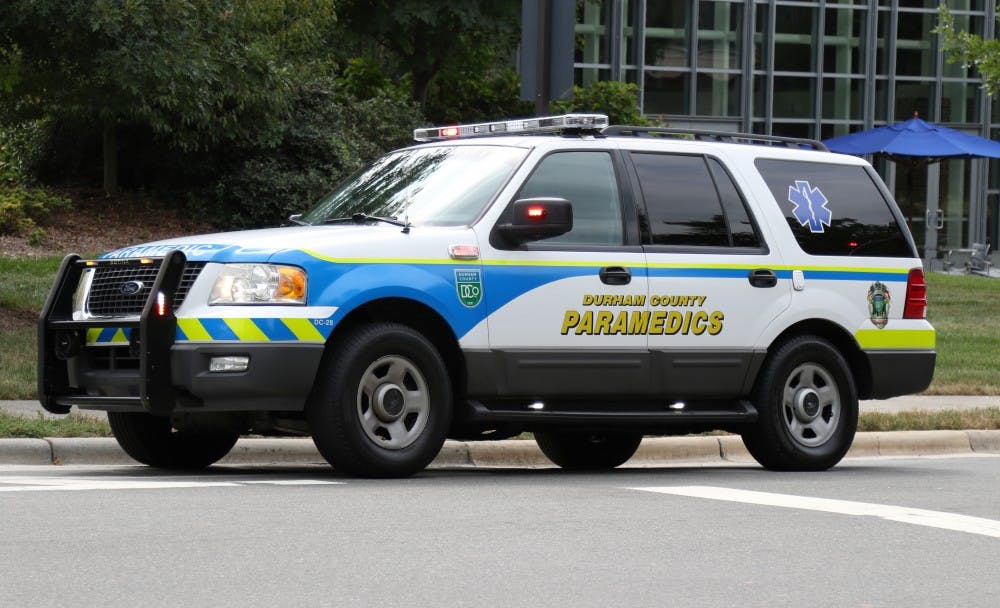Duke Emergency Medical Services is preparing an initiative to improve campus awareness on cardiopulmonary resuscitation with the help of the Duke Heart Center.
Last Tuesday night, a cardiac arrest incident was reported at Perkins Library—the first at Duke in six years according to statistics collected by Duke EMS. Although cardiac arrests account for less than one percent of calls received by the student-run first responder service, it is still a high-priority incident that warrants campus attention, said Duke EMS Director Chris Endo, a senior.
“In the past 10 to 12 years, there [were] incidents where several cardiac arrests happened on campus,” Endo said. “However, there has never been any effort by the University to promote CPR training.”
Recently, Duke EMS reached out to cardiologists at the Medical Center and the Duke Heart Center to partner on the CPR awareness initiative.
The initiative will feature 20-to-30-person classes open to Duke students, instructing them on how to perform hands-only CPR. Equipment for these courses will be provided by the Duke Heart Center Community Outreach and Education Program.
Duke EMS has previously partnered with the Duke Heart Center to offer training sessions to corporate employers in the Triangle area, as well as Duke Human Resources and groups of resident assistants on campus.
“Almost 80 percent of cardiac arrests occur at home or work and are witnessed by family, friends and coworkers—the community needs to be ready to act if they see someone collapse in cardiac arrest,” said Leatrice Martin Short, director for the Duke Heart Center Community Outreach and Education Program. “Through this strategic initiative, students serve as trained volunteers in teaching the fundamentals of compression-only CPR. This expands our reach and ultimately saves lives.”
An incident that occurred last Tuesday highlighted the need for CPR training. Several students were in a meeting with George Grody, visiting associate professor for Markets & Management Studies, when he suddenly bent over, appearing to be asleep. The students did not think much of it until his skin paled. Recognizing an emergency, they looked for help and found three Duke EMS responders—junior Kevin Labagnara, senior Kristen Bailey and junior Kirsten Bonawitz—nearby. They quickly began performing CPR on Grody and were soon joined by responder Ritika Patil, a senior, and Duke police officer Robert Knelson.
After shocking Grody with an automated external defibrillator and administering oxygen with a bag mask resuscitator, they found a pulse. Durham EMS soon arrived and took over.
“We didn’t know if he would stay alive,” Labagnara said. “[Cardiac arrest victims] still have a small chance of living even after a few hours.”
Grody is recovering at Duke Hospital after undergoing bypass surgery.
“Professor Grody is alive because someone was around that knew CPR. You should be able to do the very basic things,” Patil said.
Although it was incidental that the cardiac arrest occurred near the launch of the classes, Labagnara said that they are using it to help promote the initiative.
“It feels good to save a life,” Bonawitz noted.
Endo added that unlike conventional CPR certification classes, these courses, taught by Duke EMTs and cardiologists, will emphasize hands-only CPR—also known as bystander CPR.
Bystander CPR doubles the survival rates for patients suffering from cardiac arrests, according to a 2011 study in the New England Journal of Medicine.
“Community education is a really powerful tool,” Endo said. “We encourage students to attend these classes, and hopefully they will be able to help when they witness cardiac arrests—until professional responders [arrive on the scene].”
Although cardiac arrest is low-frequency compared to many other emergencies—including nausea, which accounted for nine percent of calls during the 2014-15 academic year—it is considered to be a high priority by Duke EMS, Endo noted.
The average response time by Duke EMS for all types of accidents is four and a half minutes, but protocols have been developed to shorten response time and maximize patient’s survival rates in high-priority incidents. The program may lower that time further because trained students will be able to help.
Get The Chronicle straight to your inbox
Sign up for our weekly newsletter. Cancel at any time.
“It’s important because cardiac arrests can happen to anyone anytime,” Endo said. “Having someone on the spot who can start doing chest compressions right away can easily increase [the patient’s] chance of survival by 10 percent.”
Adam Beyer contributed reporting. The story was updated Tuesday night with information about the cardiac arrest that occurred last Tuesday.

